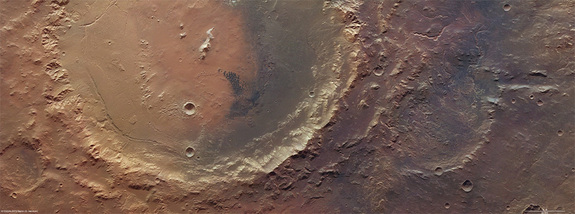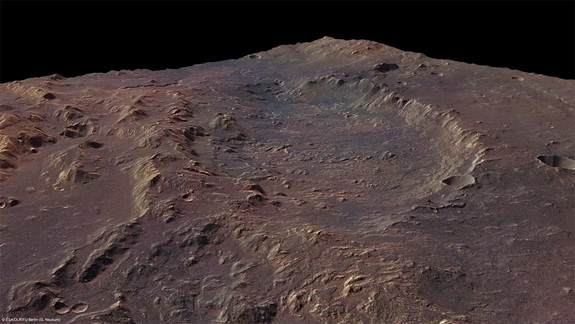Rare Sight: Ancient Mars Lake Seen in Satellite Photos

A satellite orbiting Mars has discovered evidence that a giant crater was once a water-filled lake, scientists announced today (Sept. 2).
The rare find was revealed by the presence of a delta, where flowing water has deposited sediment in a characteristic fan shape.
The 40-mile wide (65-kilometer) crater is bone dry today, but is another sign of Mars' wetter ancient past, scientists said. [See photos of Mars crater delta]
Ancient delta
The discovery was made by the European Space Agency's Mars Express satellite, which has been orbiting the Red Planet since 2003.
The delta is in the Eberswalde crater, in the southern highlands of Mars. The crater looks like a semi-circle indentation on the right side of the image. Scientists think it was formed more than 3.7 billion years ago by an asteroid that slammed into the planet.
Only the right side of the crater is intact. The rest has been covered over by the larger Holden crater, which was formed by a space rock that impacted later, kicking up debris that buried parts of Eberswalde. Holden crater can be seen toward the left of the photo.
Get the world’s most fascinating discoveries delivered straight to your inbox.
Watery past
Enough of Ebserswalde was preserved, however, that the telltale forms of the 44 square-mile (115 square km) delta can be seen. Near the top of the crater, the thin, squiggly lines represent feeder channels that would have carried water and sediment.
Overall, the delta features paint a picture of a once-full lake filling the crater, providing clear signs that the surface of Mars once flowed with liquid water.
Both Eberswalde crater and Holden crater were originally candidates for the landing site of NASA's next Mars rover, Curiosity. The rover, which will launch in November, will look for signs that Mars used to be habitable. Ultimately, Eberswalde and Holden were passed over for Gale crater, which boasts high amounts of minerals and possible signs of past water.
This story was provided by SPACE.com, sister site to LiveScience. Follow SPACE.com for the latest in space science and exploration news on Twitter @Spacedotcom and on Facebook.






